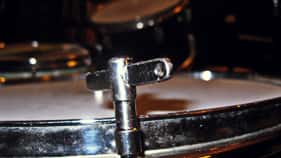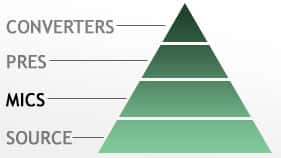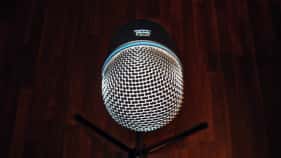
Bass Drum Miking – Capturing the Kick
Last week I wrote about snare mics and demonstrated how different mics can drastically change the sound of the drum. This week I figured I would take a similar look at bass drum miking. Used creatively, the right mic can really tailor a drum to the song at hand. Like last week, the point is not to show which microphone I think best for recording a bass drum. All the mics “hear” the kick a little differently. Bass drums sound vastly different from kit to kit. Knowing what a host of different popular mics sound like on a typical kick drum can help you decide what you want to use for a particular session.
In these examples, we are using a 16×20” 1963 Ludwig maple kick drum. It has a coated Evans EMAD head for the batter and a Remo smooth white Ambassador resonant head with a 6” mic port. It is tuned medium-low and muffled on the inside slightly – as I would for a session. All microphones are recorded through the same Vintech x81 mic pre at approximately the same apparent loudness. No eq or compression has been added so that we hear only the mic. Each mic is positioned in the way that it seems to best capture the bass drum’s sound. Some mics are too big to fit inside the drum. Some mics sound better near the port hole on the resonant head. Others sound better around the edge, and still others sound good once placed inside the drum.
Sennheiser 421
 A German dynamic classic. Since the 70s and 80s, this mic has been a popular choice for bass drum miking. It captures the punch and gives some warmth to the sound. Being a dynamic, it can handle high SPLs without damage. Just make sure it is set on “M” for Music and not “S” for Speech (“S” engages a high-pass filter and you’ll lose your bottom end). I feel this mic sounds “tight” and I use it on small kick drums.
A German dynamic classic. Since the 70s and 80s, this mic has been a popular choice for bass drum miking. It captures the punch and gives some warmth to the sound. Being a dynamic, it can handle high SPLs without damage. Just make sure it is set on “M” for Music and not “S” for Speech (“S” engages a high-pass filter and you’ll lose your bottom end). I feel this mic sounds “tight” and I use it on small kick drums.
AKG D-112
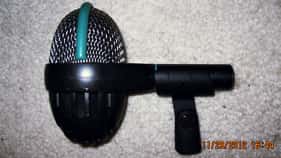 A kick drum favorite. Compared to the 421, there’s more “slap” (aka 2.5-6kHz), some mid-punch, and the kick sounds more aggressive. There’s also a little more low end. The only thing I hate about this mic is getting one inside the drum. What a ridiculous mounting system. Most of the time you have to settle for putting at the port hole in a kick (assuming you are miking a kick that makes use of a port in the front head).
A kick drum favorite. Compared to the 421, there’s more “slap” (aka 2.5-6kHz), some mid-punch, and the kick sounds more aggressive. There’s also a little more low end. The only thing I hate about this mic is getting one inside the drum. What a ridiculous mounting system. Most of the time you have to settle for putting at the port hole in a kick (assuming you are miking a kick that makes use of a port in the front head).
Shure Beta 52
 Almost as ubiquitous as the D-112, the Beta 52 features more low end and a sound that carves out a little more mid. There’s also some serious slap up top. I go to this mic a lot. I might lean more toward a D-112 if the kick drum is tuned really low or has a lot of sub energy as the Beta overemphasizes the lows.
Almost as ubiquitous as the D-112, the Beta 52 features more low end and a sound that carves out a little more mid. There’s also some serious slap up top. I go to this mic a lot. I might lean more toward a D-112 if the kick drum is tuned really low or has a lot of sub energy as the Beta overemphasizes the lows.
Blue Mouse
 This large diaphragm condenser from Blue is a fun little choice. It has a sound that balances the punch of the 421 with the low end of the beta 52 and retains a good deal of the air in the slap above 10kHz. It tends to sound big and not as focused or “hard” as the 421, D-112, or Beta 52. Just make sure you have it plugged into a pre capable of lower gains or that has a pad as this mic has a seriously hot output.
This large diaphragm condenser from Blue is a fun little choice. It has a sound that balances the punch of the 421 with the low end of the beta 52 and retains a good deal of the air in the slap above 10kHz. It tends to sound big and not as focused or “hard” as the 421, D-112, or Beta 52. Just make sure you have it plugged into a pre capable of lower gains or that has a pad as this mic has a seriously hot output.
sE H3500
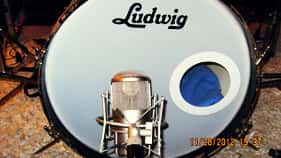 Whoa. A different sound all together. sE is a great company. I don’t believe they even make this particular mic anymore. A fat FET mic, the mic naturally breaks up a tad and compresses in a pleasing way with loud sources. There’s a natural sub and a good top. The mid could stand to be carved out. Since this mic is too big to be anywhere but outside the drum, you will have to deal more with the sound of the room and bleed from other drums. I find it useful in lower volume settings or used with a baffle setup. I love the “sonic pillow” quality it provides. Good for taming an antiseptically dead kick.
Whoa. A different sound all together. sE is a great company. I don’t believe they even make this particular mic anymore. A fat FET mic, the mic naturally breaks up a tad and compresses in a pleasing way with loud sources. There’s a natural sub and a good top. The mid could stand to be carved out. Since this mic is too big to be anywhere but outside the drum, you will have to deal more with the sound of the room and bleed from other drums. I find it useful in lower volume settings or used with a baffle setup. I love the “sonic pillow” quality it provides. Good for taming an antiseptically dead kick.
Sennheiser e906
 Just like on snare last week, it’s sometimes fun to use mics from outside the normal pool of suspects for a drum. This mic is a guitar cabinet mic with a selectable high end roll off/boost (neither is engaged in this example). Here, the kick drum sounds quirky, with lots of mid punch and few lows and highs. It’s not the right choice most of the time, but sometimes it is the absolute perfect choice.
Just like on snare last week, it’s sometimes fun to use mics from outside the normal pool of suspects for a drum. This mic is a guitar cabinet mic with a selectable high end roll off/boost (neither is engaged in this example). Here, the kick drum sounds quirky, with lots of mid punch and few lows and highs. It’s not the right choice most of the time, but sometimes it is the absolute perfect choice.
Sennheiser e602
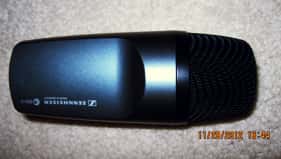 This mic has surprised me. So few people that I know refer to it, and yet it makes a kick sound pleasingly produced and EQ’d from the get go. A dynamic akin to the Beta 52 and D-112, it features a severe notch of all lower mid frequencies (from 150Hz-2kHz) – the frequencies I usually set out to attenuate first thing when EQing a kick. It also features a low and high end bump. Overall, a pleasing mic if you’re going for a produced sound.
This mic has surprised me. So few people that I know refer to it, and yet it makes a kick sound pleasingly produced and EQ’d from the get go. A dynamic akin to the Beta 52 and D-112, it features a severe notch of all lower mid frequencies (from 150Hz-2kHz) – the frequencies I usually set out to attenuate first thing when EQing a kick. It also features a low and high end bump. Overall, a pleasing mic if you’re going for a produced sound.
Neumann U-87 Ai
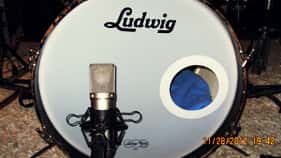 To recap from last week, the U-87 Ai is a newer mod of the heralded U-87 and features additional components that boost the output level by about 10dB. Most people feel this adds a little more “air” to the tone too. We had to place this mic outside the kick drum and so, like the H3500, you have to pay attention to room noise and drum bleed. I usually consider using this mic on a kick if I am doing jazz sessions or something that needs to feel older and “skankier.”
To recap from last week, the U-87 Ai is a newer mod of the heralded U-87 and features additional components that boost the output level by about 10dB. Most people feel this adds a little more “air” to the tone too. We had to place this mic outside the kick drum and so, like the H3500, you have to pay attention to room noise and drum bleed. I usually consider using this mic on a kick if I am doing jazz sessions or something that needs to feel older and “skankier.”
Custom-Made Reverse-Wired Subwoofer
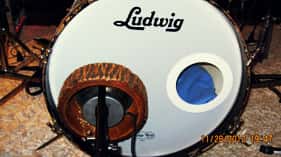 I am sure most of you are familiar with the practice of wiring a speaker to make it into a microphone. The 8” size of the subwoofer makes for a gigantic diaphragm and, best of all, it gets tons of sub and low end. I would usually never use this piece of gear as the primary mic for bass drum miking, but would instead enhance the kick sound by recording this in addition to a main kick mic and mixing the two together. This one sure does sound cool. Plus, the custom tree bark wood covering (it’s a real tree) just adds charisma points.
I am sure most of you are familiar with the practice of wiring a speaker to make it into a microphone. The 8” size of the subwoofer makes for a gigantic diaphragm and, best of all, it gets tons of sub and low end. I would usually never use this piece of gear as the primary mic for bass drum miking, but would instead enhance the kick sound by recording this in addition to a main kick mic and mixing the two together. This one sure does sound cool. Plus, the custom tree bark wood covering (it’s a real tree) just adds charisma points.
There are many more mics that I am sure I will get reprimanded for not including. Every engineer has his or her favorite. At the least, I hope this little article on bass drum miking inspires you to try different microphones to find what you like. What’s more, I hope this encourages you to try different mics for different kick drums to really find the right sound for the session. I hope you find this helpful as you setup for your next drum session!

